When the Attacking Team Precedes the Puck Over the Defending Teams Blue Line
Hockey Lingo
The Basics | Penalties | Rules | Referees | Stats Explained | Hockey 101 Links
- Bar Down: When the puck hits the bottom of the crossbar and falls across the line for a goal.
- Barn-burner: A fast-paced, high-scoring, exciting hockey game.
- Bucket: Another term for helmet.
- "Celly": Slang for "celebration" and refers to the expression of joy after a player scores a goal; a celly comes in many forms and can range from a fist pump to sheathing a stick as if it were a sword to belly-sliding across the ice. The degree of celly is typically correlated to the importance of the goal.
- Crease: Refers to the blue semi-circle directly in front of the net and goal line where the goaltender defends. Because the area is marked by blue paint, it is also referred to as "the paint."
- Flex: A measure of stiffness when force is applied to a hockey stick. Flex rating indicates how many pounds of force are necessary to bend a stick one inch. The higher the flex rating, the stiffer the stick.
- Iron: The red pipes that comprise the frame of the net. If a puck deflects off this area it is said a player "hit the iron."
- Natural Hat Trick: When a player scores three consecutive goals in a game; the slang term is "natty hatty."
- Pylon: A player – typically a defenseman – that is extremely slow on the ice and the opposition can easily skate around.
- Saucer Pass: An elevated pass; typically used to evade an opposing player's stick blocking the on-ice passing lane.
- Twig: Another term for a hockey stick that refers to the era when sticks were made from wood. Today's sticks are made of carbon fiber and graphite, which are lighter, more flexible materials.
- Wheels: A player's speed and skating ability. A fast and agile player has "good wheels."
The Playing Surface
- The ice sheet is commonly known as the rink.
- The rink is divided into zones by a red line at center ice and two blue lines.
- A standard North American rink measures 200 feet by 85 feet.
- European ice surfaces are slightly larger.
- The ice is enclosed by boards and Plexiglass.
Rink "Zones"
- The ice surface is divided into three zones.
- The area where the goal net is located is the "defending zone" for the team defending that net.
- The middle of the rink, between two blue lines, is the "neutral zone."
- The area where the opposing net is located is the "attacking zone" or "offensive zone."
The Puck
- The puck is made of black, vulcanized rubber.
- A standard puck measures one inch thick and three inches in diameter, and weighs between 5.5 and 6 ounces.
- The puck can be moved with the hockey stick or the feet, but picking it up with the hands is illegal.
The Hockey Stick
- A stick is held by each player and used to retrieve, control, carry, pass and shoot the puck.
- Goals are scored by using the stick to shoot the puck into the opponent's net.
- A shot that inadvertently deflects into the net off another player's body is allowed to stand as a goal.
The Net
- A cage measuring four feet tall and six feet wide, strung with nylon mesh in the back.
- There are two nets at opposite ends of the ice, guarded by the goaltenders.
Teams
- Each team has six players on the ice, one goaltender and five "skaters".
- The five "skaters" have assigned positions: three forwards and two defensemen.
Substitutions
- Substitutions are unlimited and can be made at any time.
- A substitution does not require an official's permission, or a stoppage in play.
- A player can join the game "on the fly" – during the flow of play – if the departing player is within five feet of the bench and not involved in the play or with an opponent.
The Face-off
- The game begins when the referee drops the puck between two opposing forwards.
- During the face-off all other players are positioned on the defensive side of the puck.
- The face-off is used to resume play following any stoppage in the game.
- There are nine designated face-off spots painted on the ice.
The Game Clock
- The game is played in three 20-minute periods.
- The clock is stopped during all stoppages in play.
Body Checking
- A player can use a shoulder, hip or torso to hit or impede an opponent, but only when the opponent is in possession of the puck.
- A body check that targets the head is illegal.
- A body check to an opponent's back is illegal if the opponent is facing the boards.
TOP
Minor Penalties
- Note that the difference between a legal check and a penalty is open to interpretation, and remains a source of dispute among fans, players, and everyone else involved in the game. A player charged with a minor penalty is sent off the ice for two minutes, with no substitution allowed. The penalty ends immediately if a goal is scored by the opposing team.
- Minor penalties are called for obstructing an opponent
- Tripping (with the stick or knee)
- Holding (with stick or hands)
- Hooking (with stick)
- Interference (checking or impeding a player without the puck)
- Penalties are called for dangerous use of the stick
- Slashing
- Spearing
- High-sticking (hitting an opponent in the head or face)
- Cross-checking (hitting an opponent with the shaft of the stick)
- Penalties are called for dangerous physical fouls
- Elbowing
- Checking from behind
- Kneeing
- Roughing (broadly defined; usually involves a wrestling or shoving match)
TOP
Major Penalties
- A player charged with a major penalty is sent off the ice for five minutes.
- The most common major penalty is fighting. If both fighters receive five-minute penalties, substitutions can be made.
- At the referee's discretion, an infraction commonly deemed a minor penalty can be increased to a major. This usually occurs if an opponent has been seriously injured, or if the referee believes there was a deliberate attempt to injure.
- A player charged with a major penalty involving serious injury or attempt to injure is ejected from the game.
- If a penalized player is ejected, a teammate is assigned to serve his major penalty. No substitution is allowed.
Basic Rules of Ice Hockey
- Closing hand on puck — Any player, other than a goaltender, who catches a puck must immediately knock or place it back down to the ice. Any violation of this will result in a two-minute minor.
- Faceoffs — All players take up set positions around one of five face-off circles on the ice. Only two players are allowed inside the circle during the faceoff. The location of the faceoff is determined by the cause of the last stoppage in play.
- Delay of Game — The following actions result in a two-minute minor penalty
- Deliberately shooting or batting the puck outside the playing area
- Deliberately displacing the goal from its normal position
- Failure to provide the proper number of players on the ice surface after a warning from an official or for making an illegal substitution
- High Sticking — When an opponent bats a puck out of the air with a stick above shoulder height, play isbe stopped, and a faceoff ensues. A goal scored by a puck that contacted a stick that was above the height of the goal crossbar is disallowed.
- Icing the puck
- Icing is when a player on his team's side of the red center line shoots the puck all the way down the ice and it crosses the red goal line at any point (other than the goal).
- Icing is not permitted when teams are at equal strength or on the power play.
- When this occurs, play is stopped and the puck is returned to the other end of the ice for a face-off in the offending team's zone.
- Icing is not called, if:
- If the goalie leaves the crease to play the puck, even if he does not touch the puck
- If an official rules an opposing player could have played the puck before it crossed the red goal line
- An official may waive off the icing call if he deems it was an attempted pass
- Offsides — A team is offside when any member of the attacking team precedes the puck over the defending team's blueline. The position of the player's skate — and not that of his stick — is the determining factor. If both skates are over the blueline before the puck, the player is offside. If he has only one skate over the blueline and one on it, he is onside.
- Overtime — Any regular-season game that ends regulation play with a tie score will go into a five-minute sudden-death overtime period. If at the end of that overtime period the game remains tied, the game will then go into a shootout. During the playoffs, there will not be a shootout and overtime periods will be 20 minutes in length.
- Penalties — Player actions that violate the rules of the game may be given penalties at the discretion of the officials. Penalties are classified into three categories: minor, major and misconduct. For a minor penalty, players are required to serve two minutes in the penalty box while their team plays short-handed. A minor penalty will expire if the opposing team scores while on the power play. Major penalties require a player to serve five minutes in the penalty box and only expire at the end of that time. Misconduct penalties vary in length.
- Penalty Shots — A penalty shot is awarded when a player is pulled down from behind on a breakaway scoring opportunity or when the net is deliberately dislodged by an opposing goaltender or defenseman.
- Power plays — When one team has more players on the ice than the other team, because one player is serving a penalty.
- Shootouts — Any regular-season game that ends overtime play with a tie score will go into a shootout. A shootout is a series of penalty shots in which each team is allowed three attempts to score in alternating fashion. If after three attempts the teams remain tied, the shootout will continue to alternate shots until one team fails to match the attempt of the other. The winner of the shootout will be awarded one goal.
TOP
Referees Calls
-
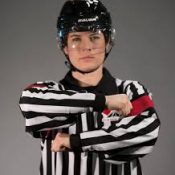 CHARGING — Rotated clenched fists in front of chest. Called for taking three or more strides before checking an opponent.
CHARGING — Rotated clenched fists in front of chest. Called for taking three or more strides before checking an opponent.
-
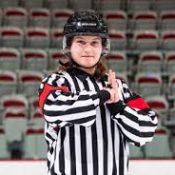 BOARDING — Pounding the closed fist of one hand into the open palm of the other hand. Called for any action which causes opponent to be thrown violently into the boards
BOARDING — Pounding the closed fist of one hand into the open palm of the other hand. Called for any action which causes opponent to be thrown violently into the boards
-
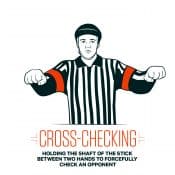 CROSS-CHECKING — A forward and backward motion with fists. Called for hitting opponent with both hands on the stick and no part of the stick on the ice.
CROSS-CHECKING — A forward and backward motion with fists. Called for hitting opponent with both hands on the stick and no part of the stick on the ice.
-
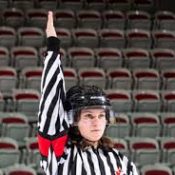 DELAYED PENALTY — Referee extends his arm above his head to indicate that a penalty has been committed by a player of the team not in possession of the puck. Call is made when the penalized team gains control of the puck or upon a stop in play.
DELAYED PENALTY — Referee extends his arm above his head to indicate that a penalty has been committed by a player of the team not in possession of the puck. Call is made when the penalized team gains control of the puck or upon a stop in play.
-
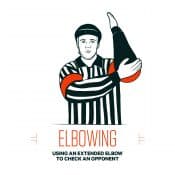 ELBOWING — Tapping the elbow with the opposite hand. Called when using the elbow to impede an opponent
ELBOWING — Tapping the elbow with the opposite hand. Called when using the elbow to impede an opponent
-
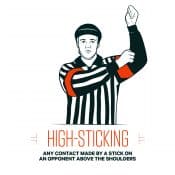 HIGH-STICKING — Holding both fists clenched, one above the other at the side of the head. Called for contacting an opponent when carrying the stick above the shoulder.
HIGH-STICKING — Holding both fists clenched, one above the other at the side of the head. Called for contacting an opponent when carrying the stick above the shoulder.
-
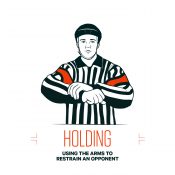 HOLDING — Clasping the wrist in front of the chest. Called for using the hands, arms, or legs to hold an opponent.
HOLDING — Clasping the wrist in front of the chest. Called for using the hands, arms, or legs to hold an opponent.
-
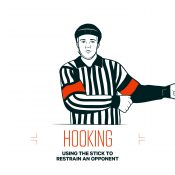 HOOKING — Tugging motion with arms. Called for using stick or blade to hook an opponent.
HOOKING — Tugging motion with arms. Called for using stick or blade to hook an opponent.
- ICING — Linesman's arms folded across upper chest.
-
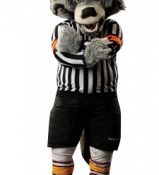 INTERFERENCE — Crossed arms in front of chest with fists closed. Called for having contact with the opponent not in possession of the puck.
INTERFERENCE — Crossed arms in front of chest with fists closed. Called for having contact with the opponent not in possession of the puck.
-
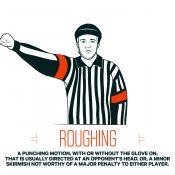 ROUGHING — A thrusting motion with the arm extending from the side. Called for engaging in fighting or shoving of a level that is not worthy of a major penalty
ROUGHING — A thrusting motion with the arm extending from the side. Called for engaging in fighting or shoving of a level that is not worthy of a major penalty
-
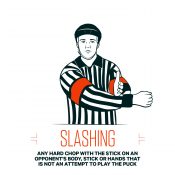 SLASHING — Chopping with one hand across the opposite forearm. Called for swinging the stick at an opponent.
SLASHING — Chopping with one hand across the opposite forearm. Called for swinging the stick at an opponent.
-
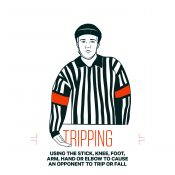 TRIPPING — Striking the right leg with the right hand, below the knee. Called for using the stick, arm, or leg to cause an opponent to fall.
TRIPPING — Striking the right leg with the right hand, below the knee. Called for using the stick, arm, or leg to cause an opponent to fall.
-
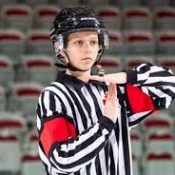 UNSPORTSMANLIKE CONDUCT — With two flat hands, form a "T" by placing the fingertips of one hand under the other hand. Called for the abuse of an official or other such misconduct.
UNSPORTSMANLIKE CONDUCT — With two flat hands, form a "T" by placing the fingertips of one hand under the other hand. Called for the abuse of an official or other such misconduct.
TOP
Hockey stat sheet abbreviations and explanations
- POS — Player position. The possible positions are C (center), LW (left wing), RW (right wing), D (defense) or G (goaltender).
- No — Player jersey number.
- GP— Games Played.
- G — Goals. A goal is awarded to the last player on the scoring team to touch the puck prior to the puck entering the net. Note: Goals scored during a shootout do not count towards a player's goal total.
- A — Assists. An assist is awarded to the player or players (maximum of two) who touch the puck prior to the goal, provided no defender plays or possesses the puck in between.
- PTS — Points. The sum of goals and assists.
- +/- — Plus-minus. See an explanation of plus minus.
- PIM — Penalty minutes.
- PP — Power play goals.
- SH — Short-handed goals.
- G — Game-winning goals. After the final score has been determined, the goal which leaves the winning team one goal ahead of its opponent is the game-winning goal (example: if Team A beats Team B 8-3, the player scoring the fourth goal for Team A receives credit for the game-winning goal). Note: Goals scored during a shootout are not credited as game-winning goals.
- S — Shots on goal. If a player shoots the puck with the intention of scoring and if that shot would have gone in the net had the goaltender not stopped it, the shot is recorded as a shot on goal.
- PCT — Shooting percentage. Divide the number of goals scored by the number of shots taken.
- PIM — Penalty minutes
GOALIE STATS EXPLAINED
- GP — Games Played
- W — Wins. A goaltender receives a win if he is on the ice when his team scores the game-winning goal.
- L — Losses. A goaltender receives a loss if he is on the ice when the opposing team scores the game-winning goal.
- SOL — Shootout losses.
- GA — Goals against
- Empty net goals do not count towards a goaltender's goals against.
- Goals scored during a shootout do not count towards a goaltender's goals against.
- SA — Shots against.
- GAA — Goals-against average
- S — Saves
- SV PCT — Save percentage
- SO — Shutouts. If two goaltenders combine for a shutout, neither receives credit for the shutout. Instead, it is recorded as a team shutout. If a regular season game is tied 0-0 at the end of overtime, both goaltenders are credited with a shutout, regardless of how many goals are scored in the shootout.
TOP
Links to additional Ice Hockey rules
- Hockey 101 — SportsNet.ca
- Ice Hockey Rules — Rules of Sport.com
- National Hockey League Rules — Wikipedia
- Official NHL Rulebook — .pdf file
- How They Play — Basic Rules of NHL Hockey
- Hockey for Dummies Cheat Sheet
- The Hockey Writers — News and Insight — Hockey 101 and much more
Source: https://www.cornellhockeyassociation.com/hockey/hockey-101/
0 Response to "When the Attacking Team Precedes the Puck Over the Defending Teams Blue Line"
Post a Comment